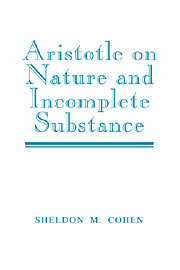3 - Elemental Transformation and the Persistence of Matter
Published online by Cambridge University Press: 05 June 2012
Summary
Aristotle's elements, we saw in Chapter 2, have a bipolar constitution: on the one hand, each element has an Internal Principle of Change (IPC) in virtue of which it is disposed to be what it is; on the other hand, each element can be driven by external forces from what it is, lose its nature, and perish. The first of these possibilities it owes to its form; the second its owes somehow to its matter.
In the last chapter we were primarily concerned with elemental motion and alteration. In this we turn to the role of these two factors (form and matter) in two basic processes: elemental transformation, which Aristotle holds is the coming-to-be and perishing of elements; and the creation of homogeneous compounds out of elements, which he holds does not involve the coming-to-be and perishing of elements. I conclude by showing how dispositional essentialism can help with some puzzles regarding the difference between these two processes.
Change and Continuity
Prime Matter
For a quarter-century Aristotle's interpreters have disagreed over his doctrine of prime matter. One school contends that Aristotle is not committed to prime matter; the other, that he is committed to it. The issue has been put with admirable clarity by H. M. Robinson:
Aristotle argues that every change has something which underlies it (e.g., 190a31–b9). What underlies a change is the matter of that change (e.g., 1042b9–11). […]
Information
- Type
- Chapter
- Information
- Aristotle on Nature and Incomplete Substance , pp. 55 - 100Publisher: Cambridge University PressPrint publication year: 1996
